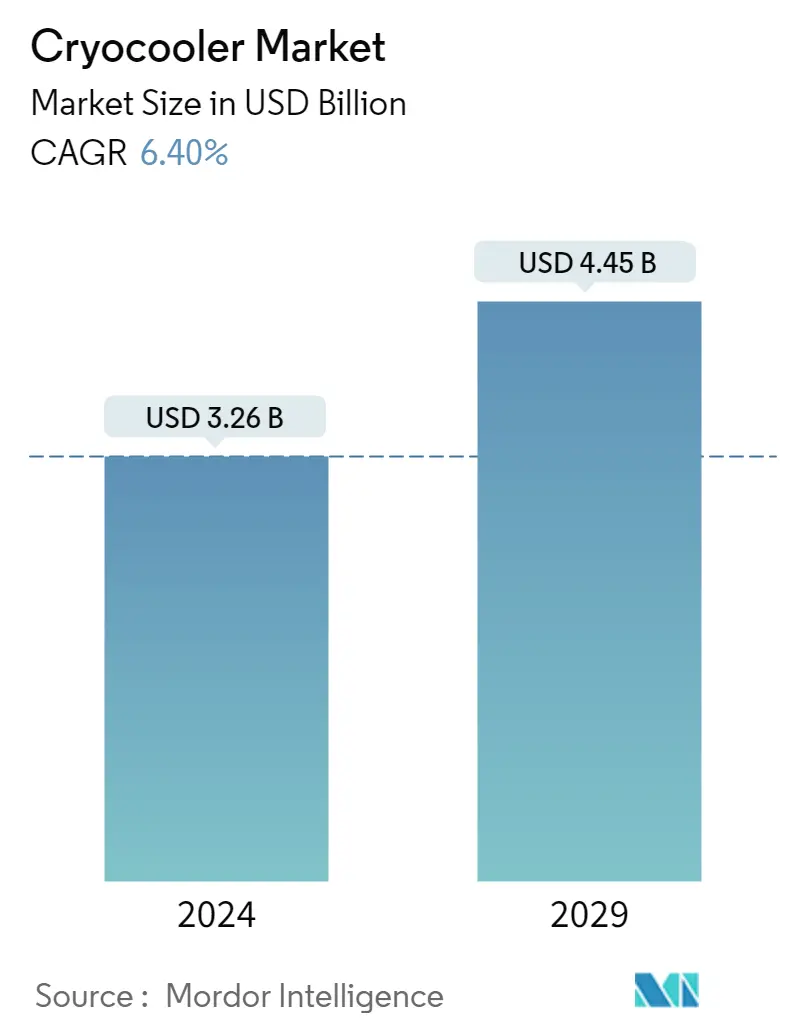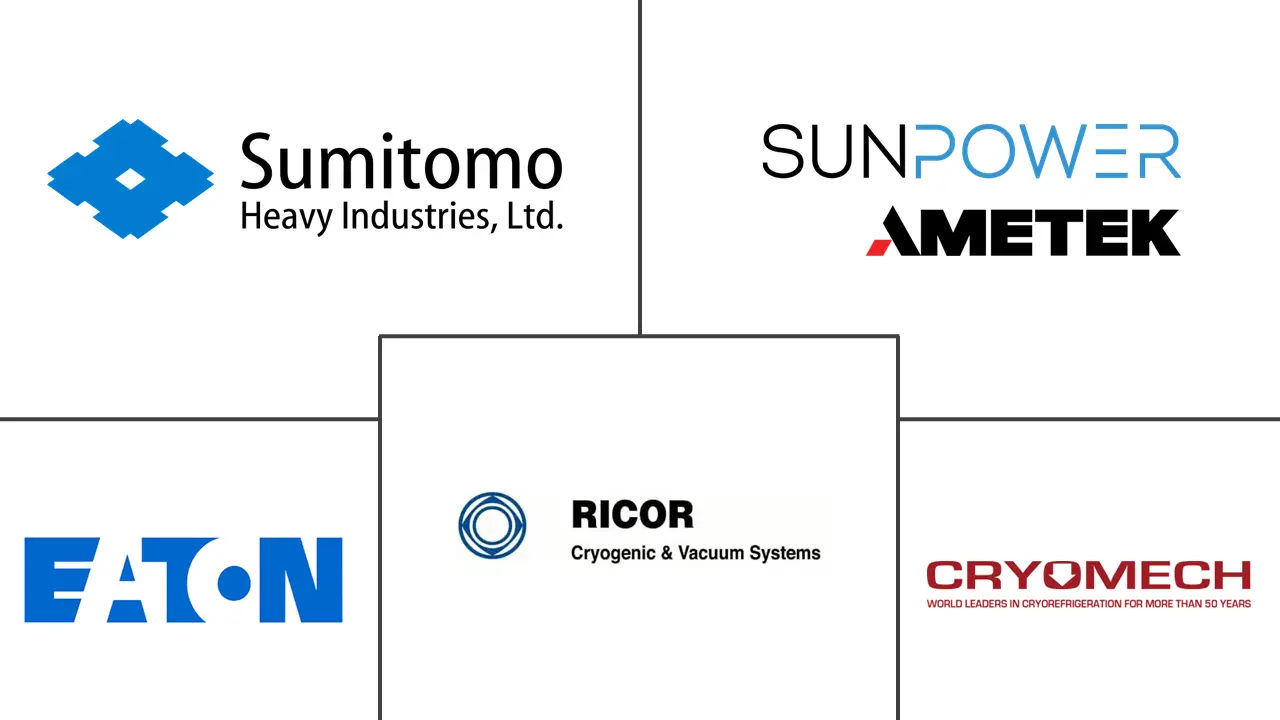Market Size of Cryocooler Industry

| Study Period | 2019 - 2029 |
| Market Size (2024) | USD 3.26 Billion |
| Market Size (2029) | USD 4.45 Billion |
| CAGR (2024 - 2029) | 6.40 % |
| Fastest Growing Market | Asia Pacific |
| Largest Market | North America |
| Market Concentration | Low |
Major Players
*Disclaimer: Major Players sorted in no particular order |
Cryocooler Market Analysis
The Cryocooler Market size is estimated at USD 3.26 billion in 2024, and is expected to reach USD 4.45 billion by 2029, growing at a CAGR of 6.40% during the forecast period (2024-2029).
- A cryocooler is a device that provides active cooling to reach cryogenic temperatures. According to the Cryogenic Society of America Inc., a cryogenic cooler or a cryocooler is designed to allow active cooling at about -150 °C. It uses the flow of gas inside closed tubes, which absorbs the temperature and radiates it outside. The device generally uses helium or a mixture of gases. These devices produce refrigeration at a specific low temperature that can replace normal cryogenic fluids. There are many types of cryocoolers, including Stirling, pulse tube, Gifford-McMahon (GM), and Joule-Thomson.
- One of the major factors driving the adoption of cryocoolers is its growing adoption across the military and defense industries to maintain cryogenic temperatures for IR sensors installed in night-vision-based systems. The use of night vision devices has significantly increased in the last few years as countries advance their defense capabilities. Moreover, countries are increasing their military spending to adopt new technologies. According to SIPRI, military spending worldwide amounted to USD 2.44 trillion in 2023, the highest amount in several decades.
- Furthermore, the cooling of infrared and visible cameras continues to provide opportunities for small cryocoolers. While recent years have witnessed a shift from cooled to uncooled IR cameras, there is still significance for high-performance infrared imagers cooled by small Stirling cycle cryocoolers. For instance, in February 2024, Prama India partnered with the Indian government's Centre for Development of Advanced Computing (C-DAC) to bolster local production and innovation. This partnership, facilitated by a transfer of technology (TOT) agreement, centers on advancing thermal camera manufacturing, marketing, and support. It signifies Prama India's stride in leveraging technology for advanced thermal camera R&D. Such government initiatives in advanced technology may further propel the market's growth.
- The need for cryocoolers in industrial processes, such as liquefaction of gases and cryogenic preservation, as well as in energy applications like superconducting magnetic energy storage (SMES) systems, is expanding, further propelling the market's growth. Also, the expanding activities in space exploration and the deployment of satellites, which rely on cryocoolers for cooling infrared sensors and other components, are significant drivers. For instance, Creare, a significant developer of cryogenic components and systems, received a new contract from NASA. The SBIR Phase II award from NASA Shared Services Center is expected to fund further expansion of a 10 K multi-stage cryocooler with very low vibration.
- Moreover, technical problems with traditional cryocoolers present several challenges to the market's growth. Traditional cryocoolers often have moving parts, such as pistons and compressors, which can wear out over time, leading to frequent maintenance and reduced reliability. This can deter potential users who require highly reliable cooling solutions for critical applications. Also, some traditional cryocoolers have relatively low thermodynamic efficiency, resulting in higher power consumption. This inefficiency can be a significant drawback in applications where energy efficiency is essential, such as in space missions or portable medical devices.
- Additionally, high inflation and rising costs of raw materials and manufacturing can impact the production costs of cryocoolers. This may affect pricing and profit margins, potentially influencing the market's growth. Furthermore, increasing focus on environmental sustainability and regulations related to energy efficiency can drive demand for more efficient cryocoolers that consume less power and have a lower environmental impact.
Cryocooler Industry Segmentation
Cryocoolers are devices that are designed to reach cryogenic temperatures, typically below 120 Kelvin (-153 °C or -243 °F). They are used in applications where extremely low temperatures are required, such as scientific research, medical imaging (MRI), and space technology. The impact of macroeconomic trends on the market is also covered under the scope of the study. Furthermore, the factors that may affect the market's evolution in the near future, such as drivers and constraints, have been covered in the study.
The cryocooler market is segmented by end-user vertical (space, healthcare, military, commercial, transportation, and other end-user verticals) and geography (North America, Europe, Asia-Pacific, and Rest of the World). The market sizes and forecasts are provided in terms of value (USD) for all the above segments.
| By End-user Vertical | |
| Space | |
| Healthcare | |
| Military | |
| Commercial | |
| Transportation | |
| Other End-user Verticals |
| By Geography | |
| North America | |
| Europe | |
| Asia-Pacific | |
| Rest of the World |
Cryocooler Market Size Summary
The cryocooler market is poised for significant growth, driven by advancements in technology that have broadened the application scope of these devices across various sectors. Cryocoolers are increasingly utilized in military and defense for cooling infrared sensors in night vision systems, as countries enhance their defense capabilities. The healthcare sector also sees a rising demand for cryocoolers, particularly in MRI systems, cryosurgery, and proton therapy, where they are essential for maintaining superconducting magnets at low temperatures. Despite challenges such as high input power consumption, the benefits and technological advancements in cryocoolers continue to foster their adoption in medical applications. Additionally, cryocoolers play a crucial role in cryopreservation processes, which are vital in fields like reproductive medicine and cancer treatment, further propelling market growth.
North America is a key region driving the cryocooler market, with substantial investments in military and healthcare sectors. The United States leads in military spending, which supports the demand for cryocoolers in defense applications. In healthcare, the region's focus on developing new cancer treatments and technologies like proton therapy contributes to market expansion. The cryocooler market is moderately fragmented, with major players such as Sumitomo and Barry Automation Inc. employing strategies like product innovation and strategic partnerships to maintain competitiveness. Recent developments, such as Cryomech Inc.'s introduction of advanced cryocooler models and strategic acquisitions, highlight the dynamic nature of the market. Collaborations in sectors like hydrogen technology and space propulsion further underscore the diverse applications and growth potential of cryocoolers.
Cryocooler Market Size - Table of Contents
-
1. MARKET INSIGHTS
-
1.1 Market Overview
-
1.2 Industry Attractiveness - Porter's Five Forces Analysis
-
1.2.1 Bargaining Power of Suppliers
-
1.2.2 Bargaining Power of Buyers
-
1.2.3 Threat of New Entrants
-
1.2.4 Threat of Substitute Products and Services
-
1.2.5 Intensity of Competitive Rivalry
-
-
1.3 Industry Value Chain Analysis
-
1.4 Technology Snapshot
-
1.5 Impact of Key Macroeconomic Trends on the Market
-
-
2. MARKET SEGMENTATION
-
2.1 By End-user Vertical
-
2.1.1 Space
-
2.1.2 Healthcare
-
2.1.3 Military
-
2.1.4 Commercial
-
2.1.5 Transportation
-
2.1.6 Other End-user Verticals
-
-
2.2 By Geography
-
2.2.1 North America
-
2.2.2 Europe
-
2.2.3 Asia-Pacific
-
2.2.4 Rest of the World
-
-
Cryocooler Market Size FAQs
How big is the Cryocooler Market?
The Cryocooler Market size is expected to reach USD 3.26 billion in 2024 and grow at a CAGR of 6.40% to reach USD 4.45 billion by 2029.
What is the current Cryocooler Market size?
In 2024, the Cryocooler Market size is expected to reach USD 3.26 billion.

